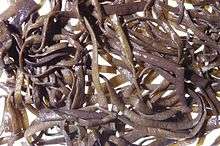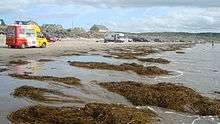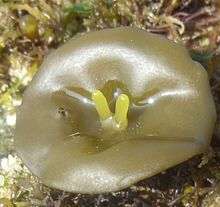Himanthalia elongata
| Himanthalia elongata | |
|---|---|
 | |
| Himanthalia elongata | |
| Scientific classification | |
| (unranked): | SAR |
| Superphylum: | Heterokonta |
| Class: | Phaeophyceae |
| Order: | Fucales |
| Family: | Himanthaliaceae |
| Genus: | Himanthalia |
| Species: | H. elongata |
| Binomial name | |
| Himanthalia elongata | |
| Synonyms[1] | |
Himanthalia elongata is a brown alga (class Phaeophyta or Phaeophyceae) in the order Fucales, also known by the common names thongweed, sea thong and sea spaghetti. [2] It is found in the north east Atlantic Ocean and the North Sea.[1]
According to the World Register of Marine Species, Himanthalia elongata is the only member of its genus, Himanthalia Lyngbye, 1819 [3] and the only member of its family, Himanthaliaceae (Kjellman) De Toni, 1891.[4]
Description

H. elongata is a common brown alga of the lower shore. The thallus is at first a small flattened or saucer-shaped disc up to three centimetres wide with a short stalk. In the autumn or winter, long thongs grows from the centre of this, branching dichotomously a number of times. They grow fast and can reach up to two metres by the following summer when they become mature. They bear the conceptacles, the reproductive organs, and begin to decay when the gametes have been released into the water. The discs live for two or three years.[5][6]

Distribution and habitat
H. elongata is found in the Baltic Sea, the North Sea and the north east Atlantic Ocean from Scandinavia south to Portugal.[7] It is found on gently shelving rocky shores in the lower littoral zone and the sublittoral zone particularly on shores with moderate wave exposure. It is sometimes abundant and forms a distinct zone just below the Fucus serratus zone.[5][6]
Culinary use
H. elongata has a history of safe use and acceptability in cooking, being appreciated for its beefy or nutty-like flavour when added in different dishes.[2] According to a 2017 paper, protein extracted from this seaweed has properties and composition (essential and non-essential amino acids) that give it potential for use in the food industry.[2]
References
- 1 2 3 Himanthalia elongata (Linnaeus) S.F.Gray, 1821 World Register of Marine Species. Retrieved 2011-09-23.
- 1 2 3 Garcia-Vaquero, M; Lopez-Alonso, M; Hayes, M (2017-09-01). "Assessment of the functional properties of protein extracted from the brown seaweed Himanthalia elongata (Linnaeus) S. F. Gray". Food Research International. 99 (Pt 3): 971–978. doi:10.1016/j.foodres.2016.06.023. hdl:10197/8228. ISSN 0963-9969. PMID 28865623.
- ↑ Himanthalia World Register of Marine Species. Retrieved 2011-09-23.
- ↑ Himanthaliaceae World Register of Marine Species. Retrieved 2011-09-23.
- 1 2 Thongweed - Himanthalia elongata Marine Life Information Network. Retrieved 2011-09-23.
- 1 2 Himanthalia elongata (Linnaeus) S.F. Gray The Seaweed Site. Retrieved 2011-09-23.
- ↑ Himanthalia elongata (Linnaeus) S.F.Gray AlgaeBase. Retrieved 2011-09-23.